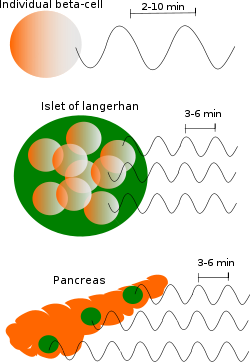
Insulin oscillations
Encyclopedia

Insulin
Insulin is a hormone central to regulating carbohydrate and fat metabolism in the body. Insulin causes cells in the liver, muscle, and fat tissue to take up glucose from the blood, storing it as glycogen in the liver and muscle....
concentration in blood increases after meals and gradually returns to basal levels during the next 1-2 hours. However, the basal insulin level is not stable. It oscillates with a regular period of 3-6 min. After a meal the amplitude of these oscillations increases but the periodicity remains constant. The oscillations are believed to be important for insulin sensitivity by preventing downregulation of insulin receptor
Insulin receptor
In molecular biology, the insulin receptor is a transmembrane receptor that is activated by insulin. It belongs to the large class of tyrosine kinase receptors....
s in target cells. Such downregulation underlies insulin resistance, which is common in type 2 diabetes. It would therefore be advantageous to administer insulin to diabetic patients in a manner mimicking the natural oscillations. The insulin oscillations are generated by pulsatile release of the hormone from the pancreas
Pancreas
The pancreas is a gland organ in the digestive and endocrine system of vertebrates. It is both an endocrine gland producing several important hormones, including insulin, glucagon, and somatostatin, as well as a digestive organ, secreting pancreatic juice containing digestive enzymes that assist...
. Insulin originates from beta cells located in the islets of Langerhans
Islets of Langerhans
The islets of Langerhans are the regions of the pancreas that contain its endocrine cells. Discovered in 1869 by German pathological anatomist Paul Langerhans at the age of 22, the islets of Langerhans constitute approximately 1 to 2% of the mass of the pancreas...
. Since each islet contains up to 2000 beta cells and there are one million islets in the pancreas it is apparent that pulsatile secretion requires sophisticated synchronization both within and among the islets of Langerhans.

Mechanism
Pulsatile insulin secretion from individual beta cells is driven by oscillation of the calcium concentration in the cells. In beta cells lacking contact, the periodicity of these oscillations is rather variable (2-10 min). However, within an islet of Langerhans the oscillations become synchronized by electrical coupling between closely located beta cells that are connected by gap junctions, and the periodicity is more uniform (3-6 min).
Adenosine triphosphate
Adenosine-5'-triphosphate is a multifunctional nucleoside triphosphate used in cells as a coenzyme. It is often called the "molecular unit of currency" of intracellular energy transfer. ATP transports chemical energy within cells for metabolism...
as well as the gasses NO
Nitric oxide
Nitric oxide, also known as nitrogen monoxide, is a diatomic molecule with chemical formula NO. It is a free radical and is an important intermediate in the chemical industry...
and CO
Carbon monoxide
Carbon monoxide , also called carbonous oxide, is a colorless, odorless, and tasteless gas that is slightly lighter than air. It is highly toxic to humans and animals in higher quantities, although it is also produced in normal animal metabolism in low quantities, and is thought to have some normal...
may be involved. The effect of these neural factors is to induce sudden dramatic elevation of calcium in the cytoplasm by releasing calcium from the endoplasmic reticulum (ER) of the beta cells. This elevation results in release of ATP from the beta cells. The released ATP in turn binds to receptors on neighbouring beta cells leading to a regenerative wave of rapid calcium elevation among the cells within the islet. This signal is believed to entrain pulsatile insulin release from the islets into a common pancreatic rhythm.
Clinical significance
The insulin oscillations are particularly pronounced in the portal vein delivering blood from the pancreas to the liver, which is a major insulin target. Disturbances of the insulin oscillations occur early in type 2 diabetes and may contribute to insulin resistance. Pulsatile insulin delivery to the portal vein or islet cell transplantationIslet cell transplantation
Islet transplantation is the transplantation of isolated islets from a donor pancreas and into another person. It is an experimental treatment for type 1 diabetes mellitus. Once transplanted, the islets begin to produce insulin, actively regulating the level of glucose in the blood.Islets are...
to the liver of diabetic patients are therefore attractive therapeutic alternatives.

